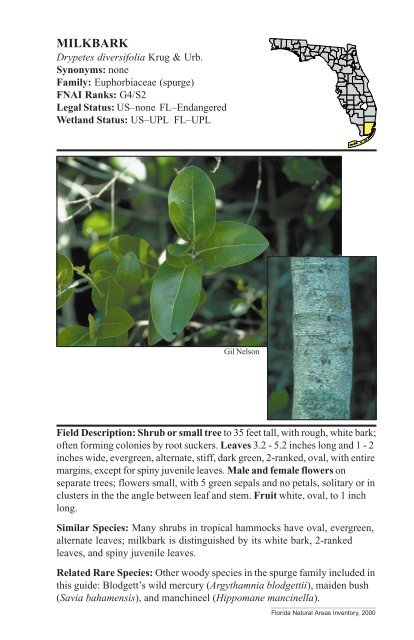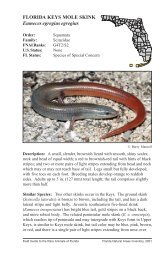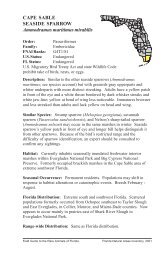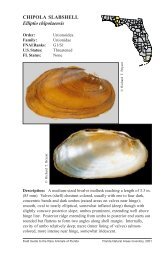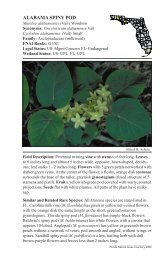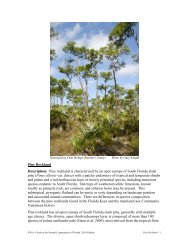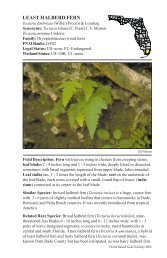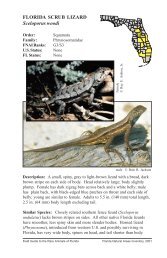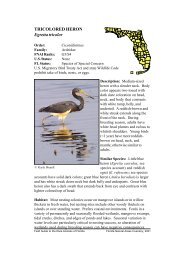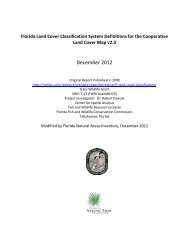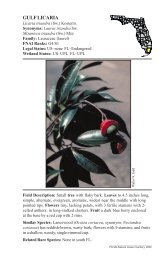MILKBARK - Florida Natural Areas Inventory
MILKBARK - Florida Natural Areas Inventory
MILKBARK - Florida Natural Areas Inventory
Create successful ePaper yourself
Turn your PDF publications into a flip-book with our unique Google optimized e-Paper software.
<strong>MILKBARK</strong><br />
Drypetes diversifolia Krug & Urb.<br />
Synonyms: none<br />
Family: Euphorbiaceae (spurge)<br />
FNAI Ranks: G4/S2<br />
Legal Status: US–none FL–Endangered<br />
Wetland Status: US–UPL FL–UPL<br />
Gil Nelson<br />
Field Description: Shrub or small tree to 35 feet tall, with rough, white bark;<br />
often forming colonies by root suckers. Leaves 3.2 - 5.2 inches long and 1 - 2<br />
inches wide, evergreen, alternate, stiff, dark green, 2-ranked, oval, with entire<br />
margins, except for spiny juvenile leaves. Male and female flowers on<br />
separate trees; flowers small, with 5 green sepals and no petals, solitary or in<br />
clusters in the the angle between leaf and stem. Fruit white, oval, to 1 inch<br />
long.<br />
Similar Species: Many shrubs in tropical hammocks have oval, evergreen,<br />
alternate leaves; milkbark is distinguished by its white bark, 2-ranked<br />
leaves, and spiny juvenile leaves.<br />
Related Rare Species: Other woody species in the spurge family included in<br />
this guide: Blodgett’s wild mercury (Argythamnia blodgettii), maiden bush<br />
(Savia bahamensis), and manchineel (Hippomane mancinella).<br />
______________________________<br />
<strong>Florida</strong> <strong>Natural</strong> <strong>Areas</strong> <strong>Inventory</strong>, 2000
Milkbark<br />
Drypetes diversifolia<br />
Habitat: Tropical hammocks in the Keys; not known from the mainland.<br />
Best Survey Season: Flowers May–June, fruits in the fall; bark and leaves<br />
are diagnostic all year.<br />
Range-wide Distribution: Dade County Keys and Monroe County Keys,<br />
FL; West Indies.<br />
Conservation Status: Approximately 25 populations are known, about<br />
half of these on 13 managed areas.<br />
Protection & Management: Eradicate exotic species from hammocks.<br />
Purchase and protect remaining tracts of tropical hammock in the Keys.<br />
References: Coile 2000, Correll and Correll 1982, IRC 1999, Nelson 1996,<br />
Tomlinson 1980, Wunderlin and Hansen 2000a.<br />
male<br />
flowers<br />
female<br />
flowers<br />
fruit<br />
spiny<br />
juvenile<br />
leaf<br />
______________________________<br />
<strong>Florida</strong> <strong>Natural</strong> <strong>Areas</strong> <strong>Inventory</strong>, 2000


